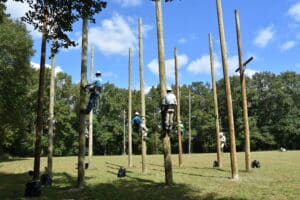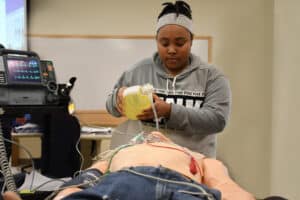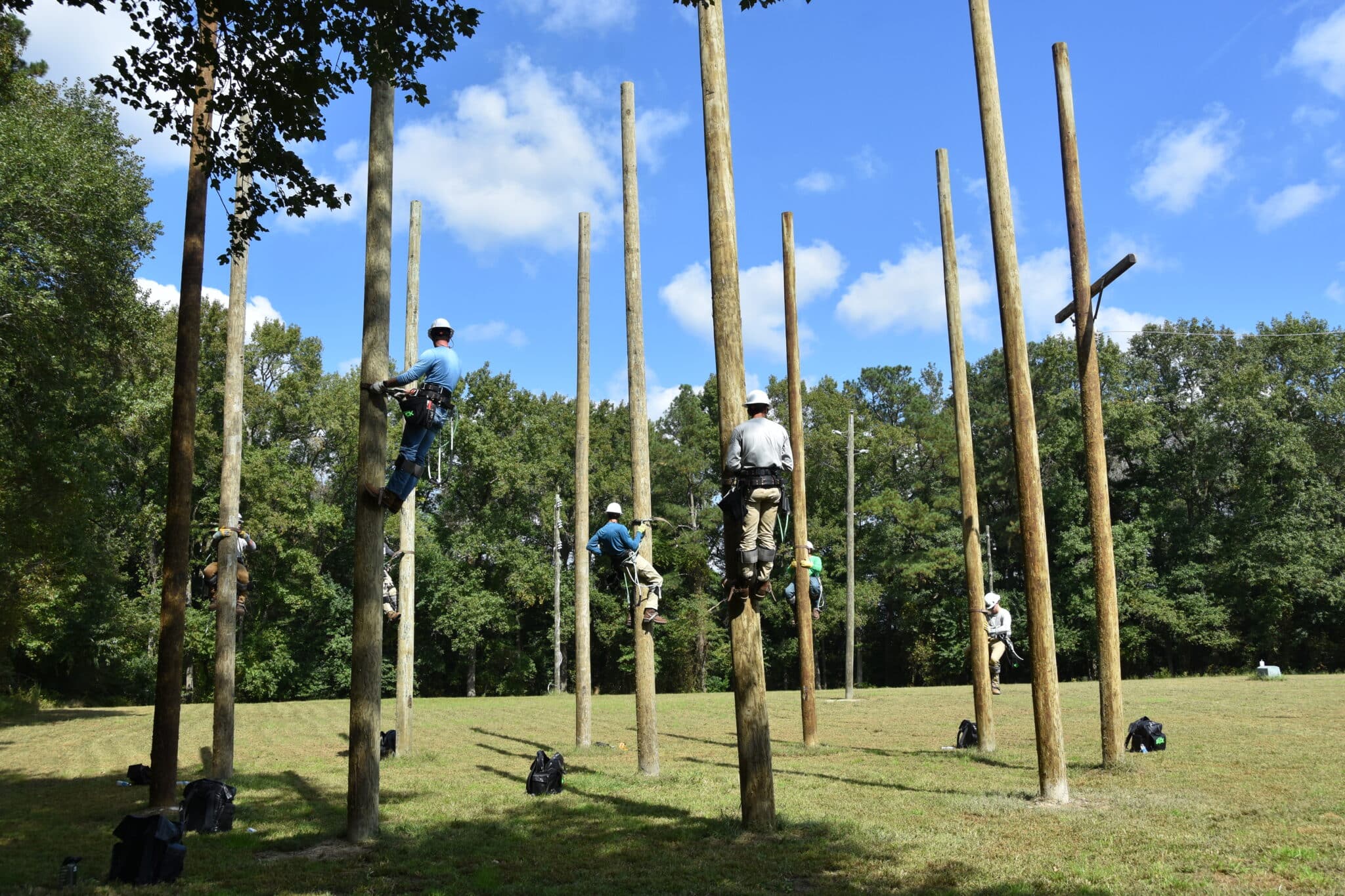The Chesapeake region, spanning six states and the District of Columbia, contains the nation’s largest estuary: the Chesapeake Bay. Tourism is strong in the region, where recreational boating is popular and oysters abound. Pollution to the region’s watershed has led to investments from the Environmental Protection Agency (EPA) and its Chesapeake Bay Program Office, allowing grantees throughout the region to work toward preserving the region’s economic and ecological well-being.
The region is also home to two community colleges that joined Achieving the Dream in 2024 and are passionate about the future of their communities in the southern Chesapeake region: Eastern Shore Community College (ESCC) in Virginia and Wor-Wic Community College in Maryland. Both colleges joined the second Accelerating Equitable Outcomes cohort, focused on rural-serving colleges. They are also geographically contiguous, separated only by the state line between Maryland and Virginia.
A new day of meeting community needs: Eastern Shore Community College
Eastern Shore or “Your Eastern Shore,” as it’s known in Accomack and Northampton counties, both of which it serves, works closely with regional and economic partners to understand its community’s needs. Under President James Shaeffer’s leadership, Eastern Shore recently completed a three-year process of transformation, enhancing its programs and services and revitalizing its culture.
One area into which the college has put considerable effort is meeting key needs in its community. Much of the region’s population is poverty impacted, and many residents are immigrants. The college is leveraging programs like adult education, English as a second language, and more, using its connections made through roundtables with community partnerships to bolster its outreach. The community partners, in turn, step in to help meet students’ needs, exemplified by a local fire station granting students access to its Wi-Fi.
In addition to providing community support services, Eastern Shore is making strides in workforce development for the region. Scott Hall, director of workforce development, and his team have infused their efforts into multiple aspects of the college, integrating workforce development into the fabric of ESCC, rather than making it a separate, siloed entity. And complementing the college’s outreach to the immigrant population through educational programs, Hall has implemented a credential evaluation process for those coming to the Eastern Shore area from other countries, enabling them to receive credit for credentials they previously earned abroad.
Now on the other end of its three-year transformation process, the college is guided by four pillars, hospitality, transparency, accountability, and inclusivity, forming what is known collectively as Eastern Shore’s “Yes” culture.
Amy Shockley, director of student services, credits the period of introspection and dedication with the creation of this positive ethos. “It did make us be laser focused on our work,” she said of the college’s process. “We knew exactly what the goals were that we had to reach.”

Internships are available through several ESCC programs. The student above worked with environmental researchers at the University of Virgina lab in Oyster, Virginia.

An Eastern Shore student uses a rotorod device to capture aeroallergens as part of a study of regional variations in pollen and fungal spores.
The result is an institution that Shockley holds dear. “I am absolutely in love with this place,” she declared. And her sentiments are for good reason. Those who work there are deeply passionate about transforming their community and increasing its vibrancy. And the excitement has only grown since the college joined the ATD Network.
“Everybody wants our students to succeed,” said Dr. Joseph (Joey) Walter, vice president of academic, student success, and workforce education. “And we’ll be using ATD as a tool to help with that.”
The enthusiasm for Eastern Shore’s next chapter of student success work is tangible on campus. As President Shaeffer noted, “It’s a new day at Your Eastern Shore.”
Strengthening the community and economy: Wor-Wic Community College
Like its neighbors at Eastern Shore just south of the state line, Wor-Wic Community College is committed to meeting the workforce needs of its community. It serves three counties: Somerset, Worcester, and Wicomico. “We are a diverse rural community,” President Deborah Casey reflected. “And Wor-Wic has clearly been a leader in making sure that we meet the needs of the diverse workforce.” Be it nursing, public safety, insurance and risk management, or a host of other areas of study, Wor-Wic is strengthening its community and economy by providing training to its diverse students.
Wor-Wic regularly disaggregates its data and has developed a host of programs to meet its students’ needs. It launched a Veterans Upward Bound program in 2018. Dr. Sheila Blosveren, professor of developmental English and director of developmental education, serves as a tutor for the program. It combines tutoring with developmental math and English instruction, providing what she described as a “double dose” of support to veterans.
Similarly, Wor-Wic’s TRIO Student Support Services program provides cohorts of students with individualized attention and additional resources. According to Dr. Kimberly Purvis, dean of student success, the cohort model is effective because of the “network of students” it creates. For both Veterans Upward Bound and TRIO, the extra attention plays a major role in showing students they belong and can be successful at Wor-Wic.

Wor-Wic Community College powerline worker pre-apprenticeship program participants scale practice poles during class.

A student practices ventilation on a manikin in the emergency medical technician program at Wor-Wic Community College.
A particular focus for Wor-Wic is supporting its part-time students, who compose 84% of the student body, in accelerating their time to degree completion and entering or reentering the workforce. To that end, Wor-Wic recently launched Expanding SUCCESS, a program led by Paul Fields, director of advising, which leverages enhanced technology to focus the college’s efforts to expedite its part-time students’ progress and momentum. Fields is well aware, however, that technology alone doesn’t create the change Wor-Wic desired for its students. “You have to have real relationships,” he said, highlighting the importance of human connection to student success.
To further help with accelerating students’ time to degree completion, Wor-Wic is transitioning to seven-week courses, which have been shown to have a notable impact on persistence and completion. This shift entailed Wor-Wic rewriting its academic calendar to align with those of local high schools and providing more evening classes for working students and parenting students. “We have to make the most of every class and the time students have here,” reflected Dr. Patricia Riley, dean of general education. Data are not yet available on the impact of transitioning to shortened academic courses, but Wor-Wic is already seeing positive trends emerging.
Wor-Wic is excited to leverage ATD’s Institutional Capacity Framework to unify all its important efforts to help students — something the college is continually striving to do. As one team member quipped, “We have more initiatives than we have people to lead them. And yet we do not have enough initiatives to meet all our students’ needs.” The deepened data analysis that Wor-Wic is already starting with ATD excites Charles (Chuck) Porter, associate professor of developmental English and department head of Arts and Humanities. “I know we’re asking the right questions now,” he said. “So, I’m optimistic. I’m looking forward to the future.”
Guiding lights for regional prosperity
As we look ahead, both Eastern Shore and Wor-Wic stand as vital pillars of opportunity in the Chesapeake region. Each institution is dedicated to addressing barriers and creating pathways for life-changing educational experiences. They are not just educational establishments; they are beacons of hope and empowerment for their communities.
In a landscape where rural institutions often grapple with unique challenges, these community colleges are rising to meet the diverse needs of their populations, fostering economic growth and enhancing social mobility.
The exciting developments at Eastern Shore and Wor-Wic are just the beginning. With a shared vision for equitable access and success, they are leveraging their strengths and partnerships to uplift their students and communities. As they continue to implement innovative solutions and deepen workforce connections, they will undoubtedly play a crucial role in shaping a brighter future for the region.
The colleges’ collective aspiration for student success is palpable, and with the resources provided by Achieving the Dream, they are well-equipped to harness their momentum. The journey forward promises not only to enhance educational outcomes but also to enrich the lives of all those in the Chesapeake region. Together, Eastern Shore and Wor-Wic are lighting the way and leading a mission of transformation.
